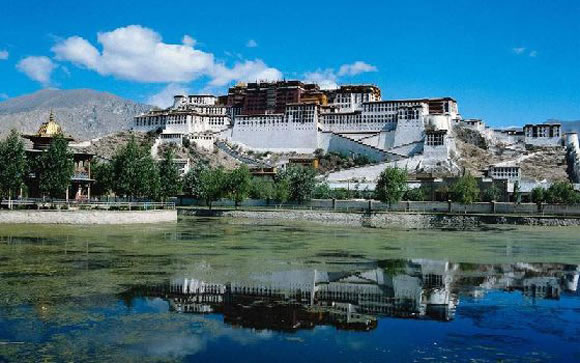

Large swathes of desert along Tibet's mother river, the Yarlung Zangpo, are now green, and trees cover formerly sandy areas that once brought sandstorms to Lhasa in late winter and early spring.
In 2013, workers planted more than 53,600 hectares of trees in soil erosion-prone areas of Lhasa, Xigaze, Shannan and Nyingchi Prefecture, mostly along the Yarlung Zangpo river, according to Liu Wei, the official in charge of the afforestation project.
"The visible benefits are fewer dusty days in Lhasa and Shannan Prefecture. The roads between the two are no longer blocked by dunes," Buchun, deputy head of Tibet's regional department of forestry, told Xinhua on Wednesday.
The Yarlung Zangpo River, the longest in Tibet, originates from the Himalayas and runs 2,057 kilometers from west to east through southern Tibet, then enters India.
Over the past three decades, the greenness of the Yarlung Zangpo basin has faded due to illegal logging by locals and overgrazing, resulting in hundreds of kilometers of desert along the river.
China started reforesting the area in 1983, while cracking down on illegal logging and setting up no-grazing zones along the river.
The improving eco-environment has also been helpful in relieving the Lhasa Gongkar Airport in the Yarlung Zangpo river valley from sandstorms and strong winds, which have long posed a safety hazard for aircraft landings.
Statistics from the Lhasa meteorological observatory show that dusty weather affecting the airport has been reduced, as the number of dusty days at the airport dropped to 100 in 2010 from 206 in the 1980s.
Due to afforestation, the number of dusty days in central Lhasa dropped to 10 days in 2013 from an average of 60 in the 1990s, said Liu Yijun, a senior engineer with the observatory.
Tibet's regional government plans to invest 30 billion yuan (about 4.8 billion US dollars) in an afforestation project to cover six major rivers, including the Yarlung Zangpo.
The project, which will begin this year, will focus on the Yarlung Zangbo, Ngulchu, Lhasa, Nyangchu, Nyakchu and Sengye Khabap rivers, said Buchun.
Workers will reforest 670,000 hectares of land to conserve soil and water resources, and the project is expected to be completed by 2030.
The efforts will be funded mainly by the central government, while local forestry authorities will make use of existing money to support the project, the second-largest in Tibet after the Qinghai-Tibet Railway, which went into operation in 2006.
Copyright ©1999-2018
Chinanews.com. All rights reserved.
Reproduction in whole or in part without permission is prohibited.